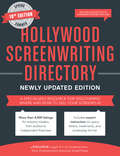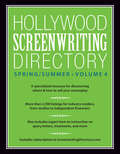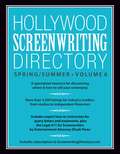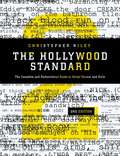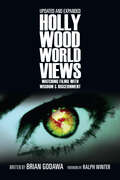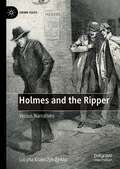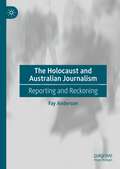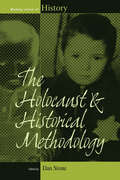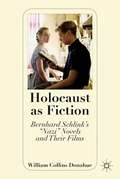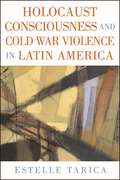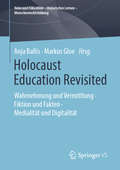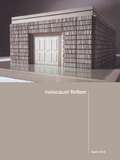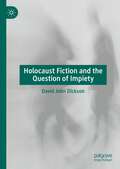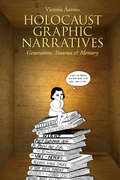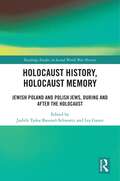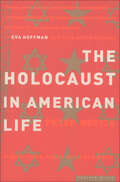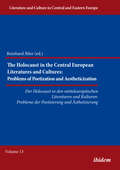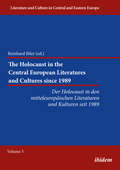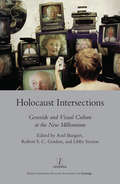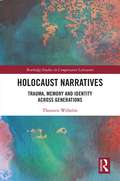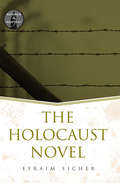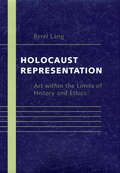- Table View
- List View
Hollywood Screenwriting Directory Spring/Summer: A Specialized Resource for Discovering Where & How to Sell Your Screenplay
by Dinah Perez Jesse DoumaReady to submit your screenplay but not sure about the logistics? With over 4,000 listings for Industry insiders such as studios, production companies, and independent financiers, this handy directory gives you the scoop on query letters, treatments and much more. Plus, the Legal 411 for Screenwriters section by entertainment attorney Dinah Perez is well worth the cost of the book. Get a head start with:Correct addresses and info for buyers (more than 4,000 listings!)The top ways to write and format loglines, treatments and query lettersInside screenwriting intelThe legalities of screenwriting and more from Dinah Perez!Up-to-Date It's true that contact information in Hollywood can change in the blink of an eye. You'll benefit from the updates to more than 50 percent of last year's listings. Also new are Facebook profiles, email addresses and more.What Matters to You Tons of information is included because so many things go into a successful submission. Browse information such as:Verified contact details, so you can email, phone or stop by in personPackaging your submission for best resultsScript formatWho receives unsolicited workThe legalities that go into each stage of the screenwriting and production processHow each financier, production company or studio wants submissions
Hollywood Screenwriting Directory Spring/Summer Volume 4: A Specialized Resource for Discovering Where & How to Sell Your Screenplay
by Writer's Store EditorsThe Hollywood Screenwriting Directory is a specialized resource for discovering where and how to sell your screenplay. It contains over 2,500 listings for Industry insiders such as studios, production companies, and independent financiers - plus, pointers to help you create a quality screenplay submission. The Hollywood Screenwriting Directory includes a free subscription to ScreenwritingDirectory.com, where screenwriters can access updated listings and market their projects to Industry Professionals.
Hollywood Screenwriting Directory Spring/Summer Volume 4
by Writer's Store EditorsThe Hollywood Screenwriting Directory is a specialized resource for discovering where and how to sell your screenplay. It contains over 2,500 listings for Industry insiders such as studios, production companies, and independent financiers - plus, pointers to help you create a quality screenplay submission. The Hollywood Screenwriting Directory includes a free subscription to ScreenwritingDirectory.com, where screenwriters can access updated listings and market their projects to Industry Professionals.
The Hollywood Standard: The Complete and Authoritative Guide to Script Format and Style (2nd edition)
by Christopher Riley"The Hollywood Standard" describes, in clear, vivid prose and hundreds of examples, how to format every element of a screenplay or television script. A reference for everyone who writes for the screen, from the novice to the veteran, this is the dictionary of script format, with instructions for formatting everything from the simplest master scene heading to the most complex and challenging musical underwater dream sequence. This new edition includes a quick start guide, plus new chapters on avoiding a dozen deadly formatting mistakes, clarifying the difference between a spec script and production script, and mastering the vital art of proofreading. For the first time, readers will find instructions for formatting instant messages, text messages, email exchanges and caller ID.
Hollywood's Eve: Eve Babitz and the Secret History of L.A.
by Lili AnolikThe quintessential biography of Eve Babitz (1943-2021), the brilliant chronicler of 1960s and 70s Hollywood hedonism and one of the most original American voices of her time. &“I practically snorted this book, stayed up all night with it. Anolik decodes, ruptures, and ultimately intensifies Eve&’s singular irresistible glitz.&” —Jia Tolentino, The New Yorker &“The Eve Babitz book I&’ve been waiting for. What emerges isn&’t just a portrait of a writer, but also of Los Angeles: sprawling, melancholic, and glamorous.&” —Stephanie Danler, author of SweetbitterLos Angeles in the 1960s and 70s was the pop culture capital of the world—a movie factory, a music factory, a dream factory. Eve Babitz was the ultimate factory girl, a pure product of LA. The goddaughter of Igor Stravinsky and a graduate of Hollywood High, Babitz, age twenty, posed for a photograph with French artist Marcel Duchamp in 1963. They were seated at a chess board, deep in a game. She was naked; he was not. The picture, cheesecake with a Dadaist twist, made her an instant icon of art and sex. She spent the rest of the decade on the Sunset Strip, rocking and rolling, and honing her notoriety. There were the album covers she designed: for Buffalo Springfield and the Byrds, to name but a few. There were the men she seduced: Jim Morrison, Ed Ruscha, Harrison Ford, to name but a very few. Then, at nearly thirty, her It girl days numbered, Babitz was discovered—as a writer—by Joan Didion. She would go on to produce seven books, usually billed as novels or short story collections, always autobiographies and confessionals. Her prose achieved that American ideal: art that stayed loose, maintained its cool; art so sheerly enjoyable as to be mistaken for simple entertainment. Yet somehow the world wasn&’t paying attention. Babitz languished. It was almost twenty years after her last book was published, and only a few years before her death in 2021 that Babitz became a literary star, recognized as not just an essential L.A. writer, but the essential. This late-blooming vogue bloomed, in large part, because of a magazine profile by Lili Anolik, who, in 2010, began obsessively pursuing Babitz, a recluse since burning herself up in a fire in the 90s. Anolik&’s elegant and provocative book is equal parts biography and detective story. It is also on dangerously intimate terms with its subject: artist, writer, muse, and one-woman zeitgeist, Eve Babitz. &“A dazzling, gossip-filled biography of the wayward genius who knew everyone in Seventies LA.&” —The Telegraph (UK)
Holmes and the Ripper: Versus Narratives (Crime Files)
by Lucyna Krawczyk-ŻywkoIn versus narratives Sherlock Holmes is fighting or otherwise engaging Jack the Ripper. These texts pit the archetypal detective against the archetypal serial killer using established formulas as well as new narrative and generic features, a combination that results in their mass appeal among authors and audiences alike. The list of primary sources includes 120 titles – novels, short stories, plays, fanfiction, ‘Grand Game’ studies, movies, TV shows, video and board games – which are treated as a dialogic network of transfictional and transmedial texts. This study unpacks the versus corpus in its media dispersal by analysing Sherlock Holmes and Jack the Ripper as serial figures and culture-texts emphasising the increasing palimpsestousness of the former and the multidirectional polymorphousness of the latter, and tracing the overlapping Doylean culture-text. It also addresses the way character constellations are represented, negotiated, and fed back into the versus network, contextualising them within the coalescence of fact and fiction, Gothic and crime fiction frames, cultural memory, neo-Victorianism, and biofiction.
The Holocaust and Australian Journalism: Reporting and Reckoning
by Fay AndersonThis book explores the Australian press reporting of the persecution and genocide of European Jews, and the extent to which the news of the Holocaust was known and believed, revealed and hidden, and acknowledged and minimised. Spanning the coverage of Hitler’s political ascent in the 1920s through to the Nazis’ extermination campaign, it culminates in the accounts of the trials of Nazi war criminals and the post-war transnational migration to Australia of Holocaust survivors, to a country far from universally welcoming in its reception of them. The book also tells the story of the journalists who reported on these tragic events and the editors who published them, along with the political, social and cultural context in which they worked, in an environment influenced by exclusionary ideas about race and nationality that did not necessarily inspire sympathy for Jews and their trauma. This book sheds light on the ethics of reporting human suffering, violence and genocide and – centrally – on the role of the press in shaping Australia’s collective memory of the Holocaust. It encourages readers to think critically about media power, public apathy, advocacy, and the importance of truth. Disturbing evidence of increasing anti-Semitism in Australia as elsewhere, along with continuing Holocaust denial, provide an additional urgency to this study.
The Holocaust and Historical Methodology
by Dan StoneIn the last two decades our empirical knowledge of the Holocaust has been vastly expanded. Yet this empirical blossoming has not been accompanied by much theoretical reflection on the historiography. This volume argues that reflection on the historical process of (re)constructing the past is as important for understanding the Holocaust-and, by extension, any past event-as is archival research. It aims to go beyond the dominant paradigm of political history and describe the emergence of methods now being used to reconstruct the past in the context of Holocaust historiography.
Holocaust as Fiction
by William Collins DonahueHolocaust as Fiction seeks to explain and critically evaluate the extraordinary success of Schlink's internationally acclaimed novel, The Reader , the widely read "Selb" detective trilogy, and two popular films based closely on his work.
Holocaust Consciousness and Cold War Violence in Latin America (SUNY series in Latin American and Iberian Thought and Culture)
by Estelle TaricaThis book proposes the existence of a recognizably distinct Holocaust consciousness in Latin America since the 1970s. Community leaders, intellectuals, writers, and political activists facing state repression have seen themselves reflected in Holocaust histories and have used Holocaust terms to describe human rights atrocities in their own countries. In so doing, they have developed a unique, controversial approach to the memory of the Holocaust that is little known outside the region. Estelle Tarica deepens our understanding of Holocaust awareness in a global context by examining diverse Jewish and non-Jewish voices, focusing on Argentina, Mexico, and Guatemala. What happens, she asks, when we find the Holocaust invoked in unexpected places and in relation to other events, such as the Argentine "Dirty War" or the Mayan genocide in Guatemala? The book draws on meticulous research in two areas that have rarely been brought into contact—Holocaust Studies and Latin American Studies—and aims to illuminate the topic for readers who may be new to the fields.
Holocaust Education Revisited: Wahrnehmung und Vermittlung • Fiktion und Fakten • Medialität und Digitalität (Holocaust Education – Historisches Lernen – Menschenrechtsbildung)
by Anja Ballis Markus GloeDer Band wendet sich Konzepten von „Holocaust Education“ zu, die auf einer Tagung an der LMU München im Februar 2018 diskutiert worden sind: Wissenschaftlerinnen und Wissenschaftler verschiedener Disziplinen reflektierten über Zieldimensionen, mediale Repräsentationen sowie Wandel und Herausforderungen bei der Vermittlung der Themenfelder Holocaust und NS-Verbrechen. Die kritische Auseinandersetzung mit Konzepten von „Holocaust Education“ hat sich auch im 21. Jahrhundert als produktiv erwiesen: Es kann ein vielstimmiger und auf die Gegenwart bezogener Diskurs entfaltet werden, der von Fragen der Vermittlung im Klassenzimmer bis zu der Virtualisierung von Zeugenschaft in Museen und daraus resultierender didaktischer Konsequenzen reicht. Der InhaltZur Einführung • Wahrnehmung und Vermittlung • Fiktionen und Fakten • Medialität und DigitalitätDie HerausgeberDr. Anja Ballis ist Professorin am Fachbereich Didaktik der deutschen Sprache und Literatur der Ludwig-Maximilians-Universität München.Dr. Markus Gloe ist Professor am Fachbereich Politische Bildung und Didaktik der Sozialkunde an der Ludwig-Maximilians-Universität München.
Holocaust Fiction
by Sue ViceExamining the controversies that have accompanied the publication of novels representing the Holocaust, this compelling book explores such literature to analyze their violently mixed receptions and what this says about the ethics and practice of millennial Holocaust literature. The novels examined, including some for the first time, are: * Time's Arrow by Martin Amis* The White Hotel by D.M. Thomas* The Painted Bird by Jerzy Kosinski* Schindler's List by Thomas Keneally* Sophie's Choice by William Styron* The Hand that Signed the Paper by Helen Darville. Taking issue with the idea that the Holocaust should only be represented factually, this compelling book argues that Holocaust fiction is not only legitimate, but an important genre that it is essential to accept. In a growing area of interest, Sue Vice adds a new, intelligent and contentious voice to the key debates within Holocaust studies.
Holocaust Fiction and the Question of Impiety
by David John DicksonThis book discusses the issues underlying contemporary Holocaust fiction. Using Gillian Rose’s theory of Holocaust piety, it argues that, rather than enhancing our understanding of the Holocaust, contemporary fiction has instead become overly focused on gratuitous representations of bodies in pain. The book begins by discussing the locations and imagery which have come to define our understanding of the Holocaust, before then highlighting how this gradual simplification has led to an increasing sense of emotional distance from the historical past. Holocaust fiction, the book argues, attempts to close this emotional and temporal distance by creating an emotional connection to bodies in pain. Using different concepts relating to embodied experience – from Sonia Kruks’ notion of feeling-with to Alison Landsberg’s prosthetic memory – the book analyses several key examples of Holocaust literature and film to establish whether fiction still possesses the capacity to approach the Holocaust impiously.
Holocaust Graphic Narratives: Generation, Trauma, and Memory
by Victoria AaronsIn Holocaust Graphic Narratives, Victoria Aarons demonstrates the range and fluidity of this richly figured genre. Employing memory as her controlling trope, Aarons analyzes the work of the graphic novelists and illustrators, making clear how they extend the traumatic narrative of the Holocaust into the present and, in doing so, give voice to survival in the wake of unrecoverable loss. In recreating moments of traumatic rupture, dislocation, and disequilibrium, these graphic narratives contribute to the evolving field of Holocaust representation and establish a new canon of visual memory. The intergenerational dialogue established by Aarons’ reading of these narratives speaks to the on-going obligation to bear witness to the Holocaust. Examined together, these intergenerational works bridge the erosions created by time and distance. As a genre of witnessing, these graphic stories, in retracing the traumatic tracks of memory, inscribe the weight of history on generations that follow.
Holocaust History, Holocaust Memory: Jewish Poland and Polish Jews, During and After the Holocaust (Routledge Studies in Second World War History)
by Judith Tydor Baumel-Schwartz Lea GanorThis volume is both a study of the history of Polish Jews and Jewish Poland before, during, and immediately after the Holocaust and a collection of personal explorations focusing on the historians who write about these subjects.While the first three parts of the book focus on "text," the broad nature of Polish Jewish history surrounding the Holocaust, the last section focuses on subtext, the personal and professional experiences of scholars who have devoted years to researching and writing about Polish Jewry. The beginning sections present a variety of case studies on wartime and postwar Polish Jews, drawing on new research and local history. The final part is a reflection on family memory, where scholars discuss their connections to Holocaust history and its impact on their current lives and research. Viewed together, the combination sheds light on both history and historians: the challenges of dealing with the history of an unparalleled cataclysm, and the personal questions and dilemmas that its study raises for many of the historians engaged in it.Holocaust History, Holocaust Memory is a unique resource that will appeal to students and scholars studying the Second World War, Jewish and Polish history, and family history.
The Holocaust In American Life
by Peter NovickThis “courageous and thought-provoking book” examines how the Holocaust came to hold its unique place in American memory (Foreign Affairs).Prize–winning historian Peter Novick explores in absorbing detail the decisions that moved the Holocaust to the center of American life. He illuminates how Jewish leaders invoked its memory to muster support for Israel, and how politicians in turn used it to score points with Jewish voters. With insight and sensitivity, Novick raises searching questions about these developments, their meaning, and their consequences. Does the Holocaust really teach useful lessons and sensitize us to atrocities, or, by making the Holocaust the measure, does it make lesser crimes seem “not so bad”? Have American Jews, by making the Holocaust the emblematic Jewish experience, given Hitler a posthumous victory, tacitly endorsing his definition of Jews as despised pariahs? What are we to make of the fact that while Americans spend hundreds of millions of dollars for museums recording a European crime, while comparatively little is done to memorialize American slavery?A New York Times Notable Book
The Holocaust in Central European Literatures and Cultures: Problems of Poetization and Aestheticization
by Reinhard IblerRelating the Holocaust to poetic and aesthetic phenomena has often been considered taboo, as only authentic testimony, documents, or at least 'unliterary', prosaic approaches were seen as appropriate. However, from the very beginning of Holocaust literature and culture, there were tendencies towards literarization, poetization, and ornamentalization. Nowadays, aesthetic approaches-also in provocative, taboo-breaking ways-are more and more frequently encountered and seen as important ways to evoke the attention required to keep the cataclysm alive in popular memory. The essays in this volume use examples predominantly from Polish, Czech, and German Holocaust literature and culture to discuss this controversial subject. Topics include the poetry of concentration camp detainees, lyrical poetry about the Holocaust, poetic tendencies in narrative literature and drama, ornamental prose about the Holocaust, and the devices and functions of aestheticization in Holocaust literature and culture.
The Holocaust in Central European Literatures and Cultures: Problems of Poetization and Aestheticization (Literature and Culture in Central and Eastern Europe #13)
by Reinhard IblerRelating the Holocaust to poetic and aesthetic phenomena has often been considered taboo, as only authentic testimony, documents, or at least 'unliterary', prosaic approaches were seen as appropriate. However, from the very beginning of Holocaust literature and culture, there were tendencies towards literarization, poetization, and ornamentalization. Nowadays, aesthetic approaches—also in provocative, taboo-breaking ways—are more and more frequently encountered and seen as important ways to evoke the attention required to keep the cataclysm alive in popular memory. The essays in this volume use examples predominantly from Polish, Czech, and German Holocaust literature and culture to discuss this controversial subject. Topics include the poetry of concentration camp detainees, lyrical poetry about the Holocaust, poetic tendencies in narrative literature and drama, ornamental prose about the Holocaust, and the devices and functions of aestheticization in Holocaust literature and culture.
The Holocaust in the Central European Literatures and Cultures since 1989: Der Holocaust in den mitteleuropäischen Literaturen und Kulturen seit 1989
by Reinhard Ibler Aleksandra Bak-Zawalski Katharina Bauer Sascha Feuchert Grzegorz Gazda Anja Golebiowski Elisa-Maria Hiemer Jiri Holy Hana Hribkova Agnieszka Izdebska Danuta Szajnert Valentina Kaptayn Malgorzata Leyko Markus Roth Wolfgang Schwarz Marija Sruk Filip Tomas Tereza Tomasova Hans-Christian Trepte Olga ZitovaThis insightful book assembles a great variety of contributions on the literature and culture of the Holocaust since 1989. Focusing on Poland, the Czech Republic, and Germany, what becomes apparent is that the Nazi genocide continues to be a pivotal issue in literature, theatre, and film. Including overviews of the literary and cultural developments of the last decades, the chapters cover a wide variety of authors of both the older and younger generation such as Ruth Klüger, Roma Ligocka, Leon Weliczker, Andrzej Bart, Marek Bienczyk, and Magdalena Tulli. The growing use of provocative and taboo-breaking forms of expression turns out to be an important instrument in keeping alive the memory of the horrible events in the collective memory.
The Holocaust in the Central European Literatures and Cultures since 1989: Der Holocaust in den mitteleuropäischen Literaturen und Kulturen seit 1989 (Literature and Culture in Central and Eastern Europe #5)
by Reinhard Ibler Aleksandra Bak-Zawalski Katharina Bauer Sascha Feuchert Grzegorz Gazda Anja Golebiowski Elisa-Maria Hiemer Jiri Holy Hana Hribkova Agnieszka Izdebska Danuta Szajnert Valentina Kaptayn Malgorzata Leyko Markus Roth Wolfgang Schwarz Marija Sruk Filip Tomas Tereza Tomasova Hans-Christian Trepte Olga ZitovaThis insightful book assembles a great variety of contributions on the literature and culture of the Holocaust since 1989. Focusing on Poland, the Czech Republic, and Germany, what becomes apparent is that the Nazi genocide continues to be a pivotal issue in literature, theatre, and film. Including overviews of the literary and cultural developments of the last decades, the chapters cover a wide variety of authors of both the older and younger generation such as Ruth Klüger, Roma Ligocka, Leon Weliczker, Andrzej Bart, Marek Bienczyk, and Magdalena Tulli. The growing use of provocative and taboo-breaking forms of expression turns out to be an important instrument in keeping alive the memory of the horrible events in the collective memory.
Holocaust Intersections: Genocide and Visual Culture at the New Millennium
by Axel BangertRecent representations of the Holocaust have increasingly required us to think beyond rigid demarcations of nation and history, medium and genre. Holocaust Intersections sets out to investigate the many points of conjunction between these categories in recent images of genocide. The book examines transnational constellations in Holocaust cinema and television in Europe, disclosing instances of border-crossing and boundary-troubling at levels of production, distribution and reception. It highlights intersections between film genres, through intertextuality and pastiche, and the deployment of audiovisual Holocaust memory and testimony. Finally, the volume addresses connections between the Holocaust and other histories of genocide in the visual culture of the new millennium, engaging with the questions of transhistoricity and intercultural perspective. Drawing on a wide variety of different media - from cinema and television to installation art and the internet - and on the most recent scholarship on responses to the Holocaust, the volume aims to update our understanding of how visual culture looks at the Holocaust and genocide today. With the contributions: Robert S. C. Gordon, Axel Bangert, Libby Saxton- Introduction Emiliano Perra- Between National and Cosmopolitan: 21st Century Holocaust Television in Britain, France and Italy Judith Keilbach- Title to be announced Laura Rascaroli- Transits: Thinking at the Junctures of Images in Harun Farocki's Respite and Arnaud des Pallieres's Drancy Avenir Maxim Silverman- Haneke and the Camps Barry Langford- Globalising the Holocaust: Fantasies of Annihilation in Contemporary Media Culture Ferzina Banaji- The Nazi Killin' Business: A Post-Modern Pastiche of the Holocaust Matilda Mroz- Neighbours: Polish-Jewish Relations in Contemporary Polish Visual Culture Berber Hagedoorn- Holocaust Representation in the Multi-Platform TV Documentaries De Oorlog (The War) and 13 in de Oorlog (13 in the War) Annette Hamilton- Cambodian Genocide: Ethics and Aesthetics in the Cinema of Rithy Panh Piotr Cieplak, Emma Wilson- The Afterlife of Images
Holocaust Narratives: Trauma, Memory and Identity Across Generations (Routledge Studies in Comparative Literature)
by Thorston WilhelmHolocaust Narratives: Trauma, Memory and Identity Across Generations analyzes individual multi-generational frameworks of Holocaust trauma to answer one essential question: How do these narratives change to not only transmit the trauma of the Holocaust – and in the process add meaning to what is inherently an event that annihilates meaning – but also construct the trauma as a connector to a past that needs to be continued in the present? Meaningless or not, unspeakable or not, unknowable or not, the trauma, in all its impossibilities and intractabilities, spawns literary and scholarly engagement on a large scale. Narrative is the key connector that structures trauma for both individual and collective.
The Holocaust Novel (Genres in Context)
by Efraim SicherThe first comprehensive study of Holocaust literature as a major postwar literary genre, The Holocaust Novel provides an ideal student guide to the powerful and moving works written in response to this historical tragedy. This student-friendly volume answers a dire need for readers to understand a genre in which boundaries and often blurred between history, fiction, autobiography, and memoir. Other essential features for students here include an annotated bibliography, chronology, and further reading list. Major texts discussed include such widely taught works as Night, Maus, The Shawl, Schindler's List, Sophie's Choice, White Noise, and Time's Arrow.
Holocaust Representation: Art within the Limits of History and Ethics
by Berel LangSince Theodor Adorno's attack on the writing of poetry "after Auschwitz," artists and theorists have faced the problem of reconciling the moral enormity of the Nazi genocide with the artist's search for creative freedom. In Holocaust Representation, Berel Lang addresses the relation between ethics and art in the context of contemporary discussions of the Holocaust. Are certain aesthetic means or genres "out of bounds" for the Holocaust? To what extent should artists be constrained by the "actuality" of history—and is the Holocaust unique in raising these problems of representation?The dynamics between artistic form and content generally hold even more intensely, Lang argues, when art's subject has the moral weight of an event like the Holocaust. As authors reach beyond the standard conventions for more adequate means of representation, Holocaust writings frequently display a blurring of genres. The same impulse manifests itself in repeated claims of historical as well as artistic authenticity. Informing Lang's discussion are the recent conflicts about the truth-status of Benjamin Wilkomirski's "memoir" Fragments and the comic fantasy of Roberto Benigni's film Life Is Beautiful. Lang views Holocaust representation as limited by a combination of ethical and historical constraints. As art that violates such constraints often lapses into sentimentality or melodrama, cliché or kitsch, this becomes all the more objectionable when its subject is moral enormity. At an extreme, all Holocaust representation must face the test of whether its referent would not be more authentically expressed by silence—that is, by the absence of representation.
